Loading…
Building On Your Basic Computer Knowledge
Basic Computer Knowledge is essential if you are to survive in the modern world. There are lots of different devices available today, catering for a whole host of different requirements.
It is inevitable that these devices will need setup and configured for your preferences, and updated to remain secure.
Here you will learn about device and component installation, configuration and updating/upgrading. This enables you to gain a new understanding of how technology works, so you get the best out of your computing investments.
Join The Human Byte — get the free BIOS Update A-to-Z guide
- Follow a safe, step-by-step BIOS update process
- Printable checklist + pitfalls to avoid
- Monthly email with practical PC tips.
- I only use your e-mail for the newsletter. Unsubscribe anytime.
Contents
- 1. Basic Computer Knowledge | American Megatrends BIOS
- 2. UEFI Firmware
- 3. Hard Disk Drives
- 4. How To Upgrade RAM
- 5. How To Install Sound Cards
- 6. How Computer Monitors Work
- 7. Apple iPads
- 8. How to Make Alt Codes And A Searchable Symbols Table
- 9. Mobile Hotspot and Tethering
- 10. How To Update Computer Drivers
- 11. How To Clone A Computer
- 12. Basic Computer Knowledge | Final Thoughts
Basic Computer Knowledge American Megatrends BIOS
The Basic Input/Output System or BIOS is a small chip found inside all computers. It checks all the parts inside your machine e.g. memory, graphics, ports etc., are in working order, and tells these components how to work together.
American Megatrends BIOS is one of the most popular BIOS' in the world. You often hear the BIOS be called Firmware, System BIOS, CMOS, Flash BIOS, ROM BIOS and RAM BIOS to name but a few.
The BIOS performs initial checks through a process called the Power On Self Test (POST). This is visible when you first switch on your device.
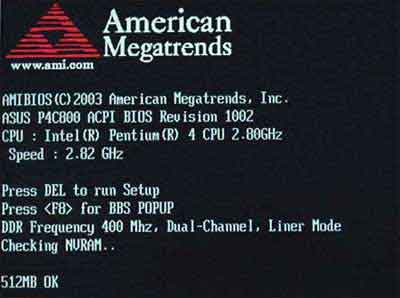 AMIBIOS Power On Self Test Screen
AMIBIOS Power On Self Test ScreenWhen the POST detects an issue or fault, it alerts you by issuing an audible beep code. In the first of a two-part tutorial, knowledge of how to interpret the fault beep codes is explained and passed on to you.
The tutorial also explains how to access and configure your BIOS settings. For example, you can set up BIOS passwords in the security menu so only you and selected members of your family can change the BIOS settings.
The American Megatrends BIOS Update page explains why updating your BIOS is a good idea, and clarifies the AMIBIOS update process, which can be difficult to understand.
One of the key steps to upgrading your BIOS is to identify the motherboard inside your computer.
Attention!
Always use the BIOS update file issued by the manufacturer of the motherboard inside your machine. If you apply the wrong BIOS update, you could corrupt your motherboard.
An important step in the BIOS or UEFI update process is the ability to quickly and easily identify your device's BIOS version. Also, in some cases, you also need to identify the details of your devices motherboard, so you know which manufacturers firmware update programs to consider.
To that end, take a look at the how to check BIOS version article, which covers the three main Windows-based techniques for identifying your device's BIOS version.
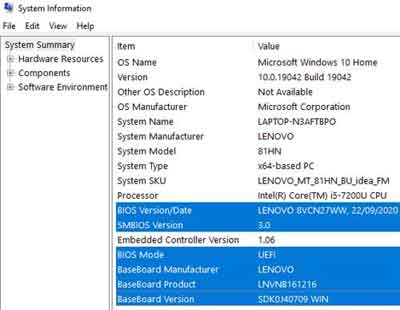 Basic Computer Knowledge
Basic Computer KnowledgeWindows Operating System MSINFO32 System Information
Return to the Table of Contents
UEFI Firmware
Modern Windows computers are now being released with the new UEFI Firmware installed. Unified Extensible Firmware Interface is a replacement for the increasing legacy computer BIOS, or Basic Input/Output System.
The increasing need for security and computing performance in today's society drive initiatives such as UEFI Firmware. Part of Apple technology for years now, we look at what UEFI offers Windows-based platforms.
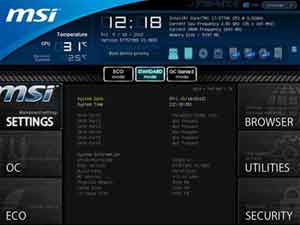 Typical UEFI Screen
Typical UEFI ScreenUEFI offers performance and security benefits. For example, UEFI completes POST tasks much more quickly and more thoroughly than the old BIOS, before handing over control to the Operating System.
Cryptography (a form of security) added to UEFI protects your machines pre-boot process against Bootkit attacks.
In addition to improved start up times and the ability to resume from hibernation much better than before (thus improving response times), UEFI Firmware also supports larger hard disk sizes and memory (RAM) capacity.
UEFI Firmware will eventually be the standard choice for all devices. Understand how this works now, so it becomes part of your basic computer knowledge.
Return to the Table of Contents
Hard Disk Drives
Hard Disks are sealed units containing different types of components that enable you to run your device and save your files.
On a traditional hard drive, your data files are actually stored inside thin, concentric circles, or bands, hosted on the hard drive's platters. These platters spin when the hard drive powers up, and the drive head reads/writes data as required e.g. loading your operating system, saving your documents etc.
You can't actually see the circles stored on the platters. They are very smooth when you open up a hard disk drive. The image below shows the different components and helps to picture how traditional hard disk drives work.
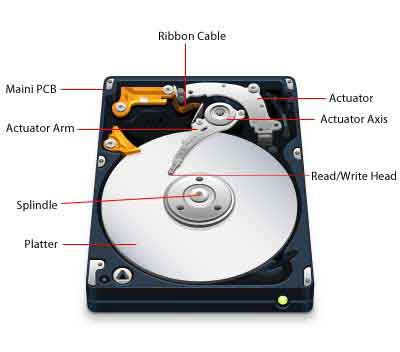 Basic Computer Knowledge
Basic Computer KnowledgeHard Disk Drive Components
Courtesy of http://www.compuclever.com
A Solid State Hard Drive or SDD, is now a viable option for computer users as costs decrease and capacity increases.
A, SSD is made up of RAM memory boards (Random Access Memory) instead of traditional rotating disk platters.
The RAM inside SSDs is non-volatile. This means that information stored in it is not lost when your machine loses power, unlike traditional computer RAM, which is volatile (Have you ever closed a document without saving and lost your data? That's volatile RAM!).
Return to the Table of Contents
How To Upgrade RAM (Random Access Memory)
Understanding how to upgrade RAM is essential to improving your computer's performance.
New machines are generally fast at first ise, but over time as we install more applications and save more file, performance reduces. This is generally because there is insufficient memory to run all the applications, games, files and browser tabs we have open.
This results in your device reverting to virtual memory to keep your system working. However, virtual memory is much slower than the physical RAM inside your machine, hence the noticeable performance drop when in use.
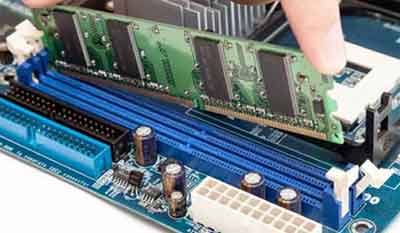 Basic Computer Knowledge
Basic Computer KnowledgeRAM Installation In Action
Source:- offtek.co.uk
This is why learning how to upgrade RAM is important, and this article walks you through the steps that you need to take to complete a memory upgrade successfully.
We identify the memory your device has installed and determine how much memory you need to get your computer performing better.
We then look at a simple trick to quickly identify the maximum amount of memory your computer can handle. This is important because you want to avoid buying too much of the wrong memory type that your computer cannot use.
We also investigate how to choose the right type of memory for your device. RAM modules come in all sorts of different types and sizes, so it is important you get this step right.
We then take a brief look at how to install your new RAM and confirm that it is being used by your computer.
Return to the Table of Contents
How To Install Sound Cards
Alongside upgrading RAM, there is an art to installing new sound cards too. The advances in sound technology allows for lots of things we take for granted, for example watching films or streaming media online, in high definition surround sound.
Increasing broadband speeds and advances in modern computing means you can communicate with friends and family members living thousands of miles away by using tools such as iPad FaceTime and Skype. All you need is a microphone or headset, which you plug into your sound card.
In addition, if you are heavily into online gaming or editing music, then a good quality sound card is essential.
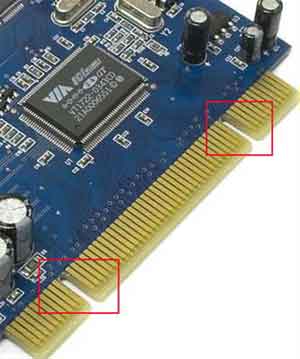 Basic Computer Knowledge
Basic Computer KnowledgeSound Card Electrical Contacts
The how to install a sound card article discuss the simple steps of physically installing an audio card. We take a look at the prerequisite steps to keep you and your system safe, and then review the steps to insert your new sound card and reassemble your machine.
To avoid any issues with your sound card, it is important the device drivers are correctly installed.
Creative Labs are one of the most popular sound card makers in the world, and therefore by way of example, Creative Labs Sound Card Drivers are used to demonstrate the driver installation process.
However, it is worth noting that the process outlined in the article is applicable to most device driver installations.
The process in a Microsoft Windows environment is very similar irrespective of the make and model of your sound card.
If you want your new sound card to work correctly, you need to install the drivers issued by the manufacturer, rather than the inbuilt Windows drivers. This is because they are technically more compatible and provide more functionality.
Return to the Table of Contents
How Computer Monitors Work
Understanding how computer monitors work can quickly get very complicated. There is lots of unfamiliar jargon to pick up such as aspect ratios, colour depth and refresh rates.
The Refresh Rate is simply the number of times the monitor updates with new images every second. The speed is measured in Hertz. The higher the refresh rate, the smoother the screen 'moves'.
The aim of this article is to both make what appears to be complex, simple to understand, and hopefully improve your all round computer knowledge when it comes to display monitors, so you make an informed choice when selecting your next monitor.
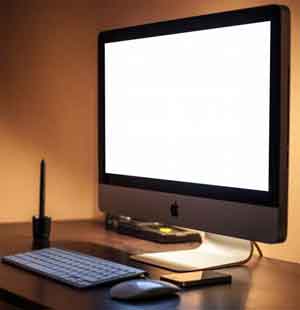 Basic Computer Knowledge
Basic Computer KnowledgeLED Monitor Example
Source:- https://pxhere.com
The article looks at the different types of monitor past and present, such as TFT's and OLEDs.
We then explore the main characteristics of modern computer monitors such as screen sizes, resolutions and the different types of connectors. Each element is important when selecting a new monitor, not just the screen size, as you will see.
Also, because we use displays more than all other parts of our computing devices, it is important to consider the capabilities of the monitor stand for ergonomic reasons. Tilt, swivel and rotate options are all important to get your posture right and avoid injury.
We also look at how the graphics and text you are looking at right now is presented on your screen. This part of the article is fairly complex, but honestly, it is understandable, and worth knowing in my humble opinion. This is how you build up your basic computer knowledge.
Return to the Table of Contents
Apple iPads
To make the best use of your iPad, we review the standard features such as cameras and volume control, and explain the different options for interacting and multitasking on your device.
This means looking at different gestures (tap, drag, pinch etc.) and running multiple apps at the same time. This section includes charts and videos to help aid understanding.
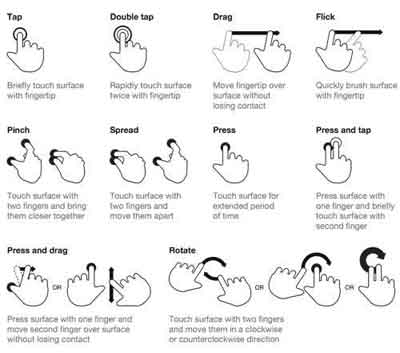 Basic Computer Knowledge
Basic Computer KnowledgeApple iPad Gesture Chart for Beginners
We also look at ways to manage your apps and apply some basic but often forgotten security settings.
I call this section Your iPad Manual, but a lot of the detail here is applicable to other iOS and even Android mobile devices.
Security is paramount today. Computer tablets are a magnet to thieves and criminals who want to steal your device or your data off it.
What would you do if someone stole your device containing sentimental and personal information, photographs and all your passwords?
One useful tool is called Find My iPad. Once enabled it allows you to track your device's movements, send an alert out and even erase your data so no one else gets their hands on it (backed up first of course!).
Return to the Table of Contents
How to Make Alt Codes And A Searchable Symbols Table
Basic computer knowledge such as how to make alt codes, is a unique but easy way to insert special characters and symbols in to your documents and e-mails.
For example, I may use an actual ÷ sign that everyone learns at school, when writing out maths calculations in an e-mail or document, rather than that standard slash (/) notation used by computers.
There are dozens of available alt codes for laptops and computers that are not displayed on a standard keyboard.
The article on how to make alt codes describes what alt codes are and their history, and explains how to access them on both laptop and desktop computer keyboards.
 Basic Computer Knowledge
Basic Computer KnowledgeAlt Code Keyboard Instruction Layout
To type a special character, symbol or code using the alt key on a traditional or standard keyboard:-
- Enable Num Lock key. A light on the key itself or at the top of the keyboard usually identifies Num Lock as enabled;
- Press and hold down the Alt Key;
- Whilst the Alt key is pressed, type the number sequence on the numeric keypad for the alt code character you wish to produce;
- Release the Alt key. The character you have requested should appear on your screen.
The image above shows the process with the relevant keyboard keys highlighted for easy reference.
Check out the searchable all alt codes and symbols chart, which is designed to make it simple for you to quickly find the symbol(s) you are looking for.
Simply use the search bar to type in the alt code reference number or description. This will filter the list to display in a shortened table what you are looking for.
If you wanted to determine the alt code for a specific symbol, or learn its description, simply paste the copied symbol in to the search bar.
Return to the Table of Contents
Basic Computer Knowledge | Mobile Hotspot and Tethering
Mobile Hotspot and Tethering services have been around for some time now. Setting up and using is more straightforward than ever before, which is good in today's connected world.
Wireless is now the most popular method of Internet connectivity, with most, if not all, mobile devices capable of connecting in this way. However, we do not yet live in a world where Wi-Fi is ubiquitously available. This is where tethering capabilities comes in.
If you have ever been on public transport, and found a long list of wireless services available to your mobile phone or Laptop, it is likely due to other passengers setting up their smartphones for tethering purposes.
In this article, we delve deep into what mobile hotspot and tethering is and how it works. We then look at how to set up tethering, which is very straightforward, and highlight a few hints and tips to make the most of your experience.
Return to the Table of Contents
How to update Computer Drivers
Understanding how to update computer drivers is critical to the normal operational routines of the sending and receiving information between your hardware and the operating system.
The communication between devices in a computer system, is key to an efficiently working computer system. It therefore makes sense to have an article that digs deep into all things device driver related.
We therefore start with the basics around what device drivers are, and how they work exactly. Understanding the fundamentals of what we are talking about really helps to provide the context for understanding the subsequent sections.
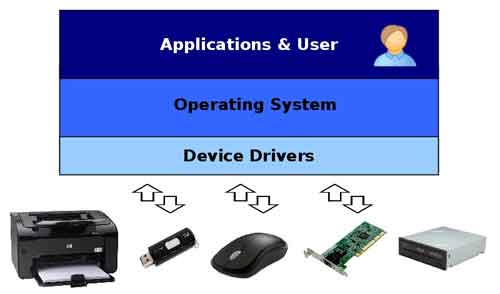 Basic Computer Knowledge
Basic Computer KnowledgeHow Device Drivers Work
Source:- flickr.com/photos/xmodulo/26775594584
We then delve into where drivers are stored in different operating systems. All files need to be stored somewhere in the File Management structure, even files for device drivers. Now we have a good driver foundation, we can look at examples of what typical device drivers are used for.
Now we are in a position to explore the step-by-step processes for installing, updating, and also removing, computer drivers. This is the main section and purpose of the article.
We then look at what to do if you receive the dreaded no device drivers are found message. The article would not complete without some pointers to how to troubleshoot computer driver issues.
Return to the Table of Contents
How To Clone A Computer
Understanding how to clone a computer is an essential skill for everyday computer users. It enables the convenient backup and restore of your entire computer system, including the operating system, device drivers, and all of your applications and files.
There is no more manually loading of all these parts that make up your computer system that can take up hours of your valuable time.
I have a simple way to clone your computer, which is completely free, and uses software called Rufus, which allows you to create a bootable USB pen, and Clonezilla, which allows you to take a cloned image of your computer.
In this article, we first look at the reasons for cloning a computer; from data backups to redundancy reasons. We then look at the tools you need for cloning, and how to use them.
Once you have a cloned your device, the process doesn't stop there. It is a regular, iterative process to capture all the changes you make from the point the clone is taken.
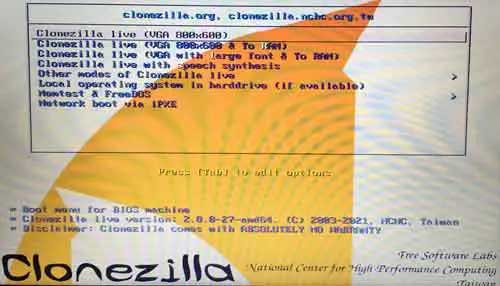 Basic Computer Knowledge
Basic Computer KnowledgeClonezilla Greeting Screen
Return to the Table of Contents
Basic Computer Knowledge | Final Thoughts
Expanding your basic computer knowledge is a must to properly manage your current devices, and new devices in the future.
Knowledge is power, as they say. Education is important to acquiring knowledge, and I believe Internet pages such as this one are key.
The following links are excellent sources of computing knowledge and education.
- TechRepbublic's 10 things to have to know to be computer literate
- Recruitment Guru's Basic Computer Knowledge article